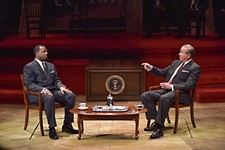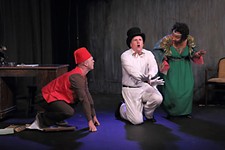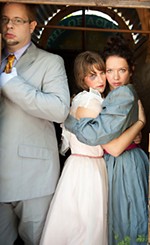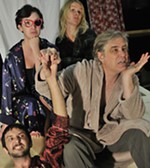Coyote on a Fence
Local Arts Reviews
Reviewed by Barry Pineo, Fri., July 26, 2002

Coyote on a Fence: Restless on Death Row
The Hideout,
through July 27
Running Time: 1hr, 50 min
Bobby and John are in adjoining cells on death row. Bobby freely admits his guilt and is ready to die. John insists on his innocence and fights to live. On the surface, it would seem a straightforward play, but we're dealing with capital punishment here, so nothing is straightforward. Bobby killed 37 people, burning them alive inside a church. A horrible, terrible, almost incomprehensible crime, certainly, but Bobby, who is racist and anti-Semitic in the extreme, sincerely believes that God spoke to him and ordered him to do it. He can even imitate God's voice, just in case you need convincing.
I feel compelled to admit that I sympathize with the politics of the play Coyote on a Fence and this local production, which are clear from the outset: Capital punishment is wrong because it is directed primarily at minorities through a culturally imposed imperative, and it is primarily visited on those, whether Hispanic, African-American, or white, who do not have the means, either financial or intellectual, to defend themselves. In case the play isn't enough to communicate these salient ideas, on the last page of the program, Real Rain Productions has provided a list that begins, "Watch the newspaper for these exciting executions brought to you by the state of Texas," giving names, ethnicities, and dates of birth, imprisonment, and upcoming execution. Six in August alone.
Politics aside, the production playing at the Hideout is uneven. Bruce Graham's script has its strengths, but it begins as a monologue play that doesn't work. John writes letters to someone on the outside, and he recites them as he's composing and after he's composed, as though he'd memorized them and is speaking directly to his correspondent. While this method of delivering exposition and illuminating character has been around forever (Shakespeare used it), it amounts to little more than intellectual laziness. Graham uses this "letter-method" throughout the production, and not just with John. In addition, another character, a prison guard, has numerous monologues delivered to an unseen person. Why not show us that other character and let us see the implied interaction, especially since the strongest scenes are those in which characters interact? Besides, director Rick Fonté sometimes has his actors blow through the monologues so quickly that we can't make out their train of thought. Fonté also has the actors, as a group, constantly move, gesture, twitch, and bounce their eyes around the stage. Undeniable tension is inherent in the dramatic situation, but rarely do the performances or the direction enhance it. The production, in a visual sense, doesn't come to rest, and any possible dramatic tension dissipates almost before it presents itself.
One of the performances did grow on me. We're supposed to like young Bobby. His anti-Semiticism is so clearly meant to be viewed as culturally imposed, you forgive him his ignorance. This forgiveness stems in large part from the way Gregg Wiggans approaches the role, bringing an innocent trust to it that, in the end, becomes otherworldly, almost beatific -- a glimpse of great human potential snuffed long before its time.










